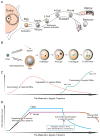The maternal to zygotic transition in mammals
- PMID: 23352575
- PMCID: PMC3669654
- DOI: 10.1016/j.mam.2013.01.003
The maternal to zygotic transition in mammals
Abstract
Prior to activation of the embryonic genome, the initiating events of mammalian development are under maternal control and include fertilization, the block to polyspermy and processing sperm DNA. Following gamete union, the transcriptionally inert sperm DNA is repackaged into the male pronucleus which fuses with the female pronucleus to form a 1-cell zygote. Embryonic transcription begins during the maternal to zygotic transfer of control in directing development. This transition occurs at species-specific times after one or several rounds of blastomere cleavage and is essential for normal development. However, even after activation of the embryonic genome, successful development relies on stored maternal components without which embryos fail to progress beyond initial cell divisions. Better understanding of the molecular basis of maternal to zygotic transition including fertilization, the activation of the embryonic genome and cleavage-stage development will provide insight into early human development that should translate into clinical applications for regenerative medicine and assisted reproductive technologies.
Keywords: 5-carboxylcytosine; 5-formylcytosine; 5caC; 5fC; ART; DMR; DNA methylation; DNA methyltransferases; DNMTs; Gamete recognition; Histone modification; ICR; MZT; Maternal effect genes; Maternal to zygotic transition (MZT); Mouse fertilization; Piwi-interacting RNA; RNA interference; RNAi; SCMC; SCNT; Subcortical maternal complex (SCMC); TDG; TRC; ZGA; Zygotic genome activation (ZGA); assisted reproductive technology; differentially methylated regions; double strand RNA; dsRNA; endo-siRNA; endo-small interfering RNA; imprinting control regions; maternal to zygotic transition; miRNA; microRNA; piRNA; somatic cell nuclear transfer; subcortical maternal complex; thymine-DNA glycosylase; transcription required complex; zygotic genome activation.
Copyright © 2013 Elsevier Ltd. All rights reserved.
Conflict of interest statement
The authors declare no competing financial interests.
Figures



References
-
- Aapola U, Kawasaki K, Scott HS, Ollila J, Vihinen M, Heino M, Shintani A, Minoshima S, Krohn K, Antonarakis SE, Shimizu N, Kudoh J, Peterson P. Isolation and initial characterization of a novel zinc finger gene, DNMT3L, on 21q22.3, related to the cytosine-5-methyltransferase 3 gene family. Genomics. 2000;65 (3):293–298. - PubMed
-
- Abdalla H, Yoshizawa Y, Hochi S. Active demethylation of paternal genome in mammalian zygotes. J Reprod Dev. 2009;55 (4):356–360. - PubMed
-
- Adenot PG, Mercier Y, Renard JP, Thompson EM. Differential H4 acetylation of paternal and maternal chromatin precedes DNA replication and differential transcriptional activity in pronuclei of 1-cell mouse embryos. Development. 1997;124 (22):4615–4625. - PubMed
-
- Aoki F, Worrad DM, Schultz RM. Regulation of transcriptional activity during the first and second cell cycles in the preimplantation mouse embryo. Dev Biol. 1997;181 (2):296–307. - PubMed
-
- Arney KL, Bao S, Bannister AJ, Kouzarides T, Surani MA. Histone methylation defines epigenetic asymmetry in the mouse zygote. Int J Dev Biol. 2002;46 (3):317–320. - PubMed
Publication types
MeSH terms
Grants and funding
LinkOut - more resources
Full Text Sources
Other Literature Sources

